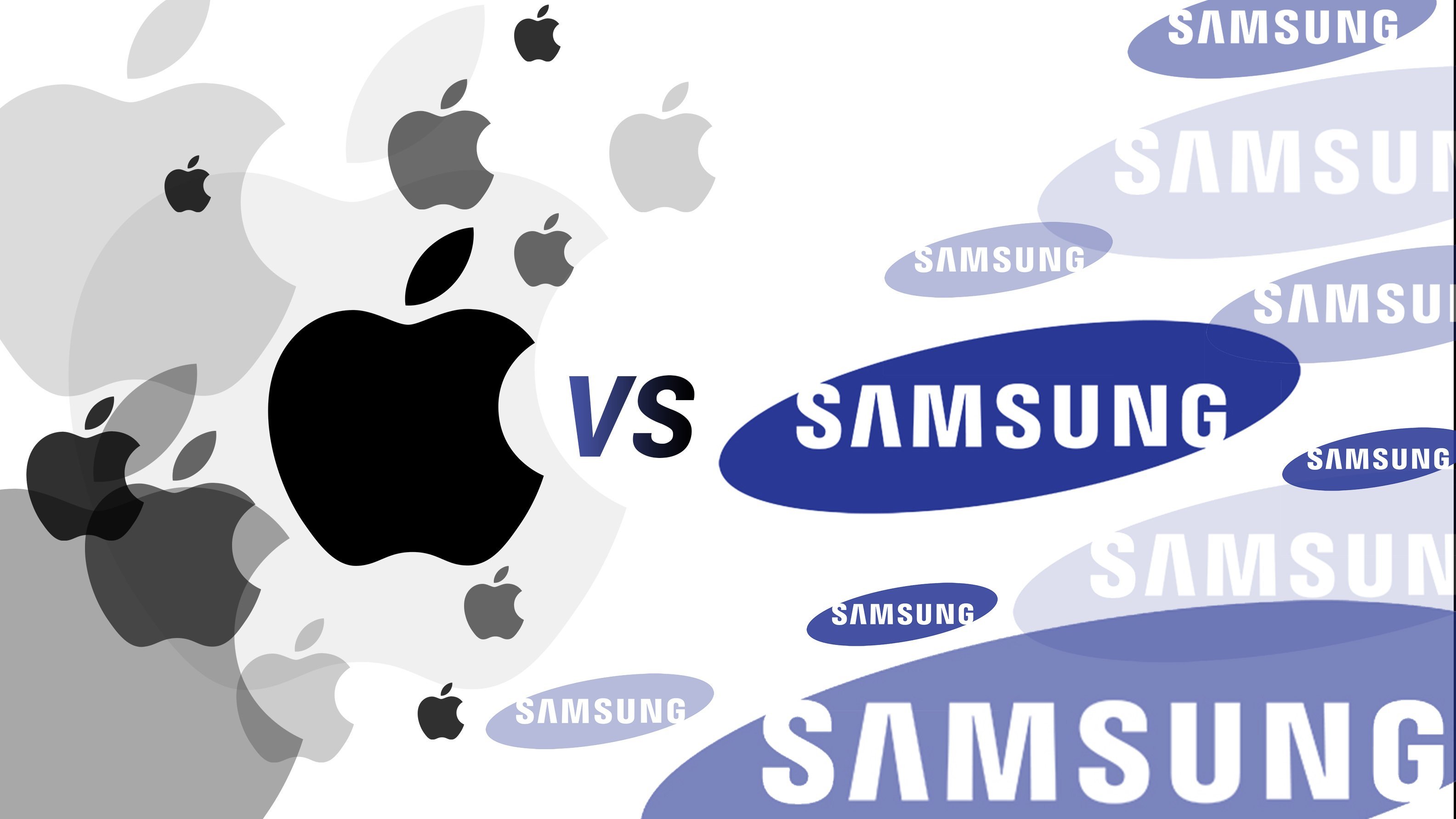
Expert’s Rating
Pros
- Good image quality
- HDR support
- Can be used with multiple devices
- Variable refresh rate up to 144Hz
- Elegant design
Cons
- Stand sold separately for $99
- Blacks aren’t as deep as Apple Studio Display
- No built-in speakers, microphone, or webcam
Our Verdict
The Spectrum One with Gorilla Glass is a 4K, 27-inch display that’s an affordable alternative to Apple’s Studio Display (which starts at $1,599). It has good color quality, high brightness, and a variable refresh rate. Its black reproduction isn’t as deep as the Apple Studio Display, but the Spectrum One is a good choice for all kinds of use cases.
Price When Reviewed
$799 without stand
Best Prices Today: Spectrum One 4K Gorilla Glass
Apple makes nice displays, but sheesh, they are expensive. So, when a display like Dough’s Spectrum One with Gorilla Glass is released, it certainly catches a shopper’s eye. Priced at $898 (that’s $799 for the display and $99 for the stand), it’s considerably cheaper than the $1,599 Apple Studio Display.
It’s easy to find a 27-inch, 4K display that’s cheaper than the Studio Display, but they are not usually on par with Apple’s quality. The Spectrum One, however, comes very close–so close that for a lot of people, it’s a viable alternative to the Studio Display. As you might expect, a few compromises are made, but you also get a few features that you either can’t find or have to pay extra for in the Studio Display.
(If you are thinking of buying the Spectrum One, you should know about Dough’s history. It used to be Eve, but it developed a bad reputation due to problematic products and customer service. I can’t speak to the company’s current service record, but the switch to Dough involves efforts to provide better service and products to reestablish itself and clean up its image.)
Specifications
| Size | 27 inches |
| Glass front | Corning Gorilla Glass with DXC |
| Aspect ratio | 16:9 |
| Native resolution | 3840 by 2160 |
| Panel type/Backlight | IPS/white LED |
| Response time | 5 ms typical 1 ms overdrive |
| Contrast ratio | 1,000:1 |
| Frequency | 48Hz to 144Hz |
| Color depth | 10-bit |
| Brightness | 450 nits typical; 750 nits maximum |
| Dimension with stand (horizontal) | 23.9 x 22.5 x 8.9 inches (607 x 571 x 227 mm) highest height 23.9 x 17.7 x 8.9 inches (607 x 449 x 227 mm) lowest height |
| Weight with stand | 18.8 lbs (6.7 kg) |
Design and build
Here’s a nitpicky detail that only Mac users can understand. One of the problems with non-Apple displays is that they don’t match the Apple design aesthetic. This is a trivial issue, but doggonit, third-party designs are often downright ugly.
That’s not the case with the Spectrum One. It doesn’t look like an Apple product, but it does look nice. The display’s aluminum stand is a gray shade that’s not the same as Apple’s Space Gray, but it doesn’t clash with it.
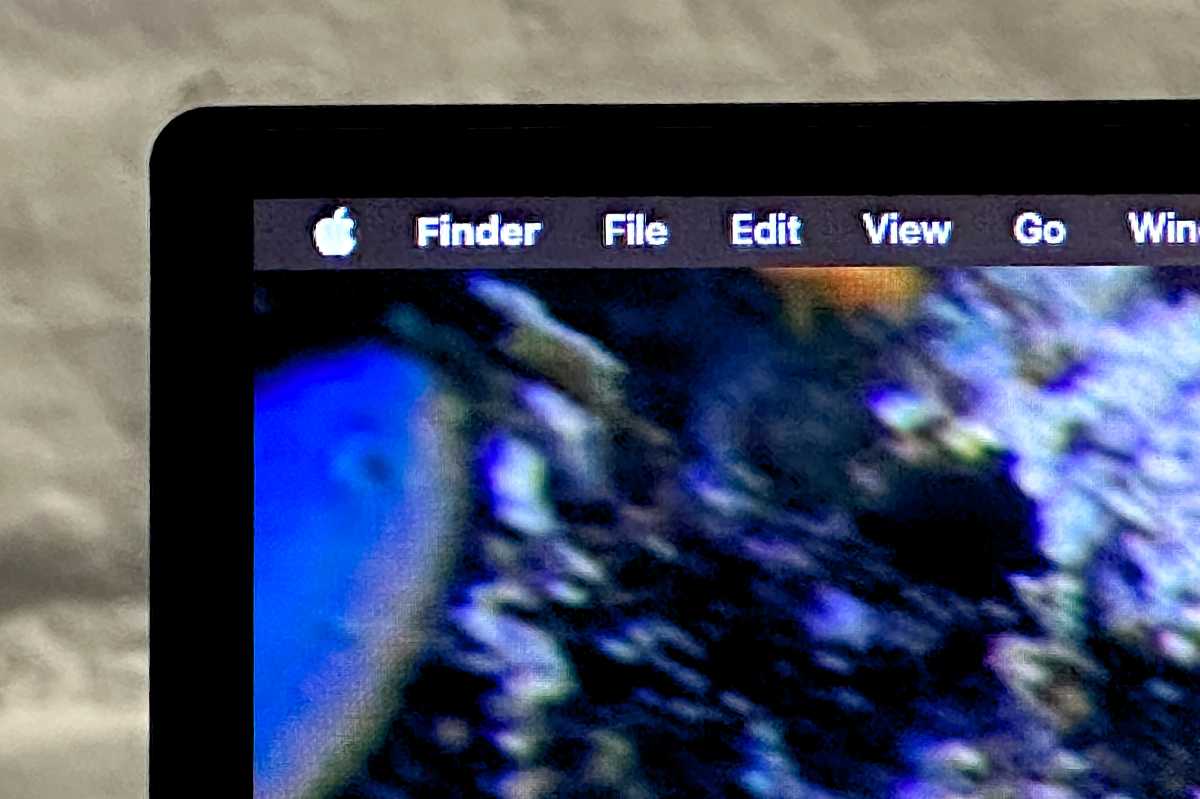
The top, left, and right bezels on the Spectrum One display are thinner than on the Apple Studio Display.
Foundry
Overall, the Spectrum One feels like a solid, sturdy display. That’s especially important if you want to pivot the display from time to time, which you can do.
The display has a thin bezel that’s about a quarter-inch thick around the top and sides, and they’re thinner than the Studio Display’s half-inch bezel. The Spectrum One’s bottom bezel is thicker, but it doesn’t stand out.
The Spectrum One display in this review has a Corning Gorilla Glass with DXC front, and according to Dough, this glass increases the ambient contrast ratio by 40 percent and reduces reflection by 70 percent when compared to other Spectrum One displays, which have glossy or matte glass. Compared to the standard semi-glossy glass on the Apple Studio Display, the Gorilla Glass appears more matte-like and it does a better job of diffusing glare. With a completely black Desktop, the Studio Display’s black looks deeper while the Spectrum One has a bit of a frosted look to it.
Display stand
The Spectrum One’s stand does not come with the display but is a separate part that you’ll have to pay $99 for. The stand attaches to the VESA mount; it snaps into place and can be easily removed. The stand does offer a good array of adjustments: its vertical tilt goes 7 degrees up or 23 degrees down, it can pivot 90 degrees, and it has a height adjusting range of 122 millimeters.
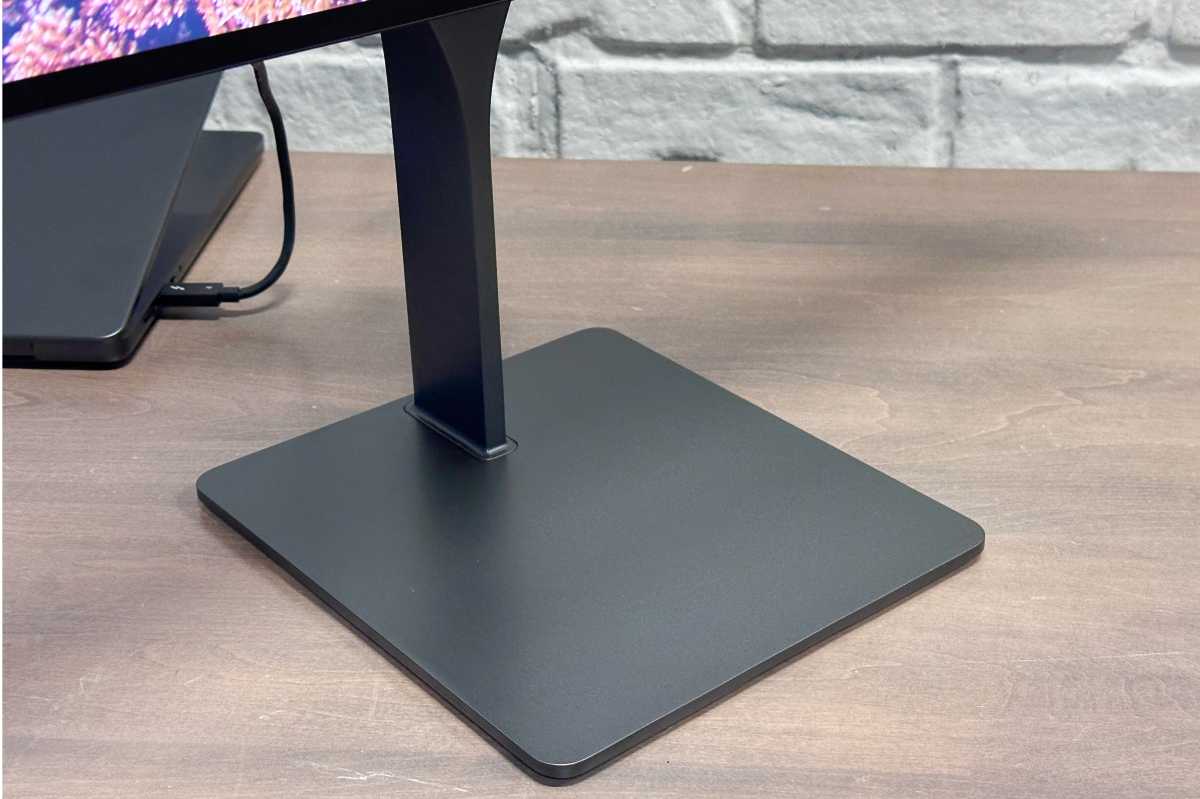
Sold separately for $99, the Spectrum One’s stand offers tilt and height adjustment and can pivot 90 degrees.
Foundry
If the $99 for the stand is a letdown, consider that the stand included with Apple’s Studio Display does not have height adjustment. Apple does offer a stand with that, but you’ll have to pay an additional $400.
Ports
The Spectrum One connects to the Mac through a USB-C port that also supplies 100 watts of power throughput to charge a connected MacBook. A Mac can also use one of the two HDMI 2.1 ports, but by connecting through USB-C you’ll also be able to use the display as a hub and its other USB-C port (15 watts), the two USB-A ports, and the 3.5 mm audio jack. There’s also a USB-B port so PCs can use the display as a port hub and DisplayPort.
Built-in controls
The back of the Spectrum One has a mini joystick that’s easy to reach when sitting in front of the display–it’s at the bottom center of the back. When you push it down, a control panel appears and the joystick is used to navigate settings, including Picture settings such as Brightness, Contrast, Color temperature, and Sharpness settings.
It’s important to know about this control panel because you’ll need to access it to tweak the image quality–especially the Brightness, which I’ll discuss in the “Image and video quality” section.

A connection hub and on-display control joystick are on the back of the Spectrum One.
Foundry
You can connect multiple devices to the Spectrum One, even a game console like an Xbox or PlayStation. (After all, the Spectrum One was initially designed as a gaming display.) And thanks to its variable refresh rate–which includes the ability to run at 120Hz–gameplay will be smooth. You can’t get 120Hz on a Studio Display if you’re able to connect a console to it in the first place–it doesn’t have HDMI, so you have to use an HDMI to Thunderbolt adapter.
In macOS’s Display System Settings, the Spectrum One can be adjusted for its refresh rate. You can set it to Variable, which adjusts the rate on the fly between 40 and 144Hz, or you can select a rate. You can also turn on the option to adjust the display to show high dynamic range (HDR) content and pick a color profile. The brightness can’t be set through System Settings, only through the display’s control panel.
Image and video quality
I used macOS Sonoma’s terrific wallpapers as well as some personal photos and videos to test the image quality of the Spectrum One, and overall, the image quality is impressive. The colors are rich, vibrant, and accurate, and the detail is sharp. To me, the Spectrum One looks more accurate in some instances while the Studio Display comes off as too lively.
But as I mentioned when I covered the Gorilla Glass on the display, the Spectrum One’s black isn’t as rich or deep as that on the Apple Studio Display. It doesn’t detract from the overall image quality, it’s just… different.

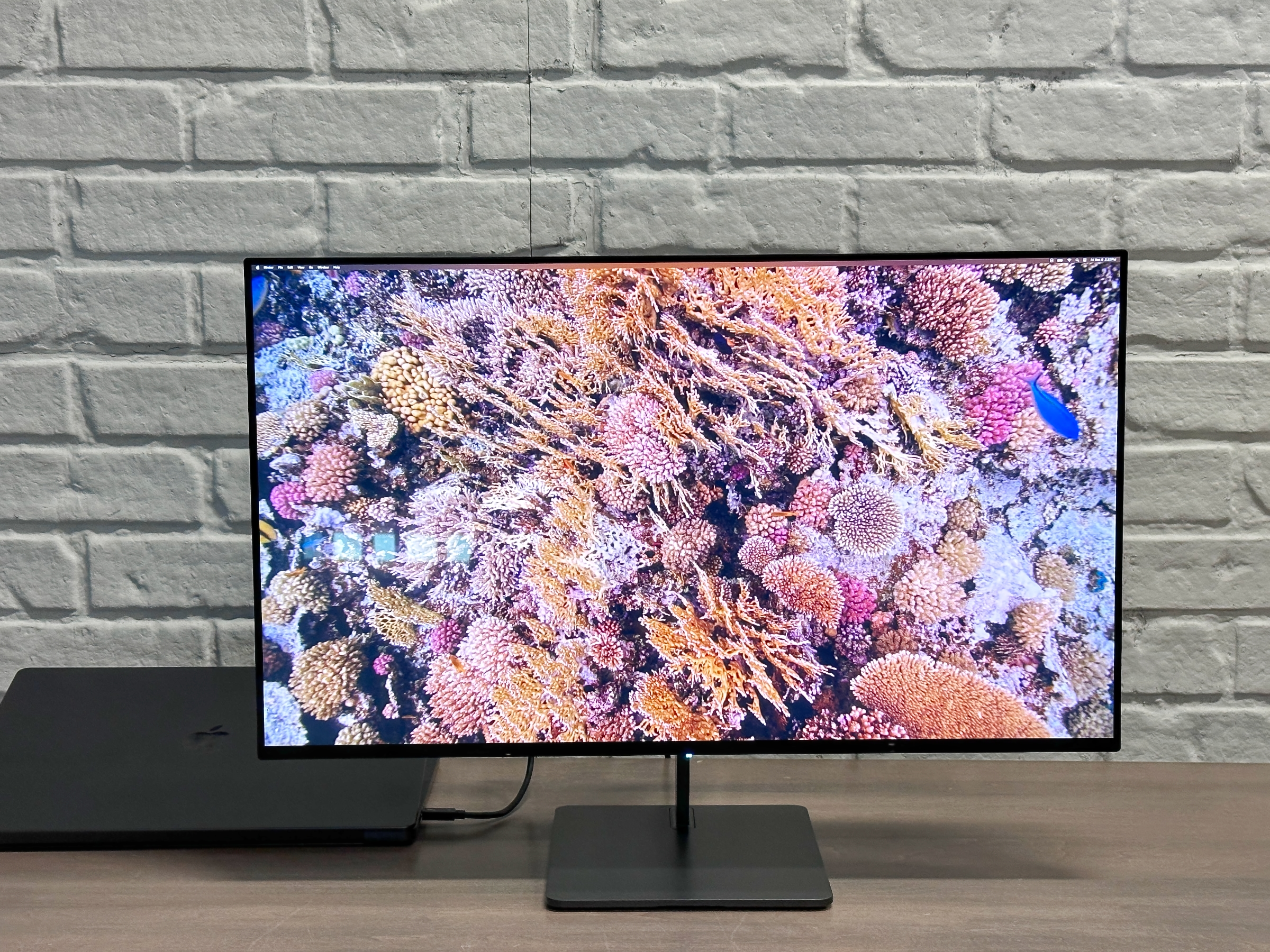
The 4K videos I played ran smoothly and I didn’t notice any off-putting artifacts. To check the Spectrum One’s response rate, I ran Resident Evil: Village with macOS Sonoma’s Game Mode turned on. The difference was subtle when switching between 60Hz and 144Hz, but the game did look smoother at the faster refresh rate, which is key for first-person shooters. The variable and higher refresh rate feature is one that you can’t find on the Studio Display, which is fixed at 60Hz.
One major advantage the Spectrum One has over the Studio Display is that it supports HDR10, a standard high-dynamic range format. HDR can be turned on and off in the Display System Settings, but if you’re viewing or working in HDR content, you’ll definitely want it on–it makes a dramatic difference. When viewing HDR videos, I noticed an improvement in the contrast and detail with HDR. For example, in this video, you can see much more skin texture with HDR on the Spectrum One than with HDR off or compared to the Studio Display.
The Spectrum One has a typical brightness of 450 nits, but its maximum brightness is 750 nits, which is 150 more than the Studio Display. The brightness, however, is a big factor when you’re setting up the Spectrum One. According to the display’s built-in control panel, the default brightness is set to “50,” which I assume is 50 percent of the maximum 750 nits. In any case, it looks too dim, especially when sitting next to a Studio Display. When I turned it up to 80 and 90, it looked to be more on par with Apple’s display, and turning it up to 100 made it a tad brighter by comparison. Turning up the brightness also helped cut down the glare of the glass.
The Spectrum One does not have built-in speakers, microphones, or a camera. If you want these features, you’ll have to resort to external solutions. If you’re particular about audio and image quality, you probably prefer to go this route even if those parts as built-in because you can get speakers and a mic that produce much better quality.
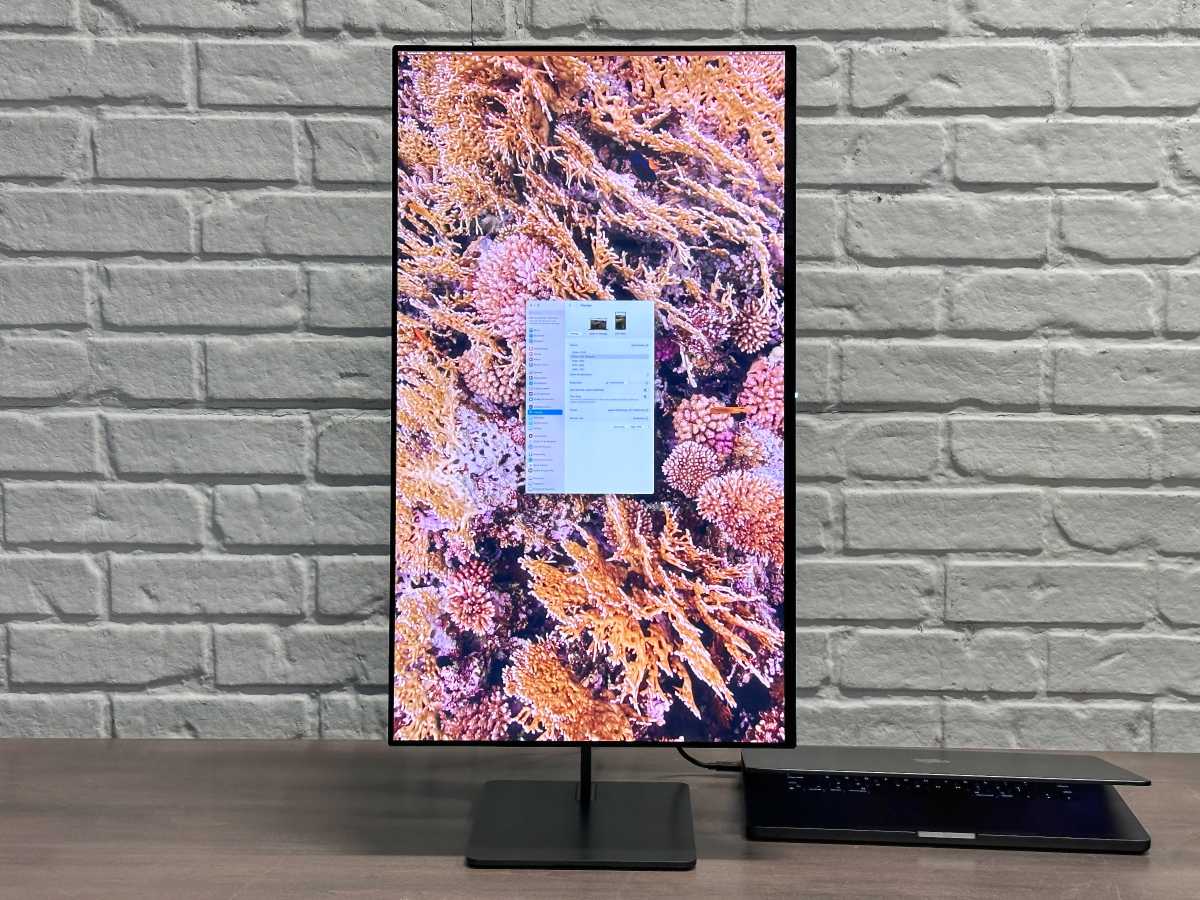
The Spectrum One can pivot to a vertical position.
Foundry
As for the camera, you can use an iPhone and take advantage of macOS’s Continuity Camera. The iPhone’s camera is much better equipped to handle different lighting situations and it produces great video quality. You’ll need to get a mount like Belkin’s iPhone Mount with MagSafe for Mac Desktops and Displays ($39.99).
The Spectrum One has a nifty feature called Split Screen mode, where the display can show two sources at once. Unfortunately, the two screens don’t completely fill the display; each screen occupies 50 percent of the horizontal display width. Split Screen is turned on through the display’s control panel.
Price
The Spectrum One with Gorilla Glass is $799 without a stand. You can supply your own stand to connect to the VESA mount, or you can pay an additional $99 for a stand. Even at $898 (including a stand), that price is much more palatable for a lot of customers than the $1,599 Apple Studio Display with the semi-glossy standard glass and a stand that does not offer height adjustment.
Other 27-inch 4K displays can be found for under $799, but they don’t offer a variable refresh rate or a glass front like the Spectrum One’s Gorilla Glass. They also may use twisted nematic (TN) or vertical alignment (VA) display technologies, which are cheaper but tend to have lesser overall image quality than IPS or LED.
Should you buy the Spectrum One with Gorilla Glass?
The Spectrum One with Gorilla Glass is worth a look if you’re in the market for a display and cringe at the $1,599 starting price of the Apple Studio Display. There are a few trade-offs: it’s 4K resolution rather than 5K, and it lacks speakers, a microphone, and a webcam. Its overall image quality isn’t as good as the Studio Display, but it’s still very good for even professional-level image work. It had a few advantages over the Studio Display, such as a variable refresh rate to a maximum of 144Hz, a higher maximum brightness, its $99 stand has height adjustment, and it can connect to game consoles at 120Hz. Overall, it’s a display that’s worth the investment.


